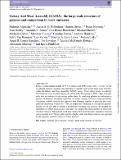Galaxy And Mass Assembly (GAMA) : the large-scale structure of galaxies and comparison to mock universes
Abstract
From a volume-limited sample of 45 542 galaxies and 6000 groups with z ≤ 0.213, we use an adapted minimal spanning tree algorithm to identify and classify large-scale structures within the Galaxy And Mass Assembly (GAMA) survey. Using galaxy groups, we identify 643 filaments across the three equatorial GAMA fields that span up to 200 h−1 Mpc in length, each with an average of eight groups within them. By analysing galaxies not belonging to groups, we identify a secondary population of smaller coherent structures composed entirely of galaxies, dubbed ‘tendrils’ that appear to link filaments together, or penetrate into voids, generally measuring around 10 h−1 Mpc in length and containing on average six galaxies. Finally, we are also able to identify a population of isolated void galaxies. By running this algorithm on GAMA mock galaxy catalogues, we compare the characteristics of large-scale structure between observed and mock data, finding that mock filaments reproduce observed ones extremely well. This provides a probe of higher order distribution statistics not captured by the popularly used two-point correlation function.
Citation
Alpaslan , M , Robotham , A S G , Driver , S , Norberg , P , Baldry , I , Bauer , A E , Bland-Hawthorn , J , Brown , M , Cluver , M , Colless , M , Foster , C , Hopkins , A , Van Kampen , E , Kelvin , L S , Lara-Lopez , M A , Liske , J , Lopez-Sanchez , A R , Loveday , J , McNaught-Roberts , T , Merson , A & Pimbblet , K 2014 , ' Galaxy And Mass Assembly (GAMA) : the large-scale structure of galaxies and comparison to mock universes ' , Monthly Notices of the Royal Astronomical Society , vol. 438 , no. 1 , pp. 177-194 . https://doi.org/10.1093/mnras/stt2136
Publication
Monthly Notices of the Royal Astronomical Society
Status
Peer reviewed
ISSN
0035-8711Type
Journal article
Description
MA acknowledges funding from the University of St Andrews and the International Centre for Radio Astronomy Research. ASGR is supported by funding from a UWA Fellowship. PN acknowledges the support of the Royal Society through the award of a University Research Fellowship and the European Research Council, through receipt of a Starting Grant (DEGAS-259586). MJIB acknowledges the financial support of the Australian Research Council Future Fellowship 100100280. TMR acknowledges support from a European Research Council Starting Grant (DEGAS-259586).Collections
Items in the St Andrews Research Repository are protected by copyright, with all rights reserved, unless otherwise indicated.

